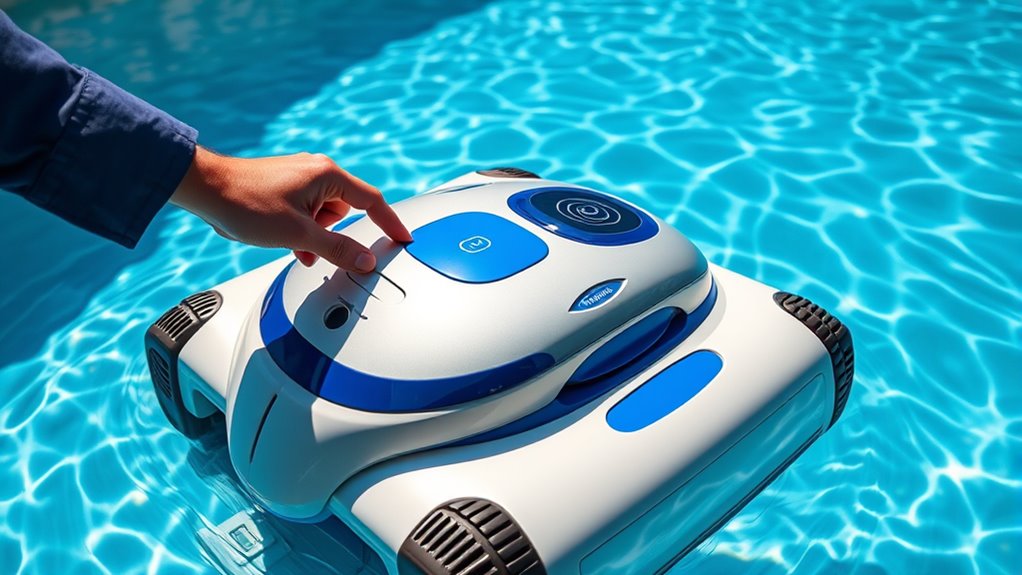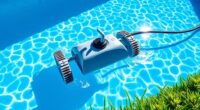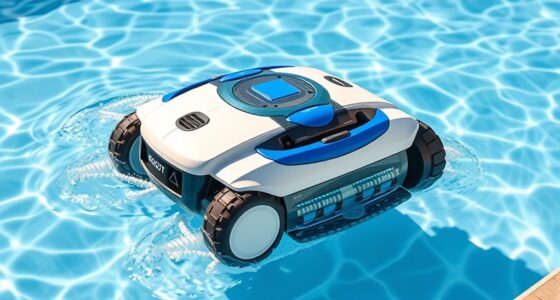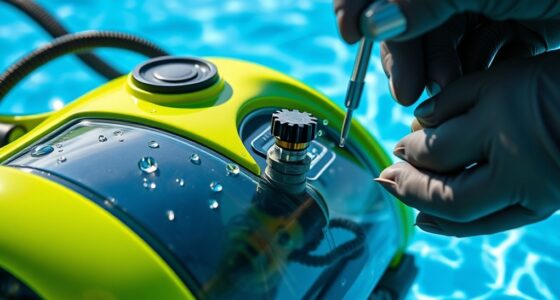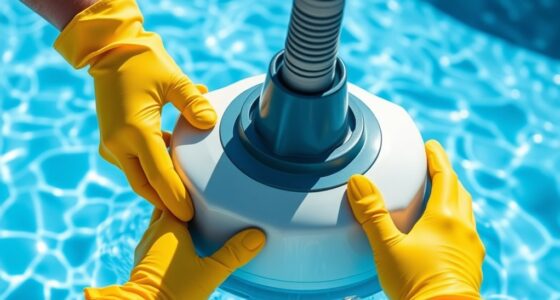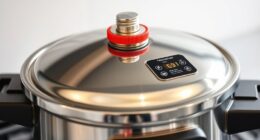To switch from a suction to a pressure pool cleaner, start by evaluating your pool’s size, shape, and surface to guarantee compatibility. Gather all necessary tools, like hoses, fittings, and adapters, and prepare your pool by balancing chemicals and removing debris. Next, disconnect and store your old suction cleaner, then connect your new pressure cleaner to the filter system. For detailed steps on setup, troubleshooting, and maintenance, continue exploring the process carefully.
Key Takeaways
- Turn off the pump, disconnect the suction cleaner, and thoroughly clean and store it properly.
- Gather compatible hoses, fittings, and adapters to connect the pressure cleaner to your pool’s pump system.
- Ensure your pool’s pump and filter can handle the increased flow and pressure requirements of the new cleaner.
- Install the pressure cleaner according to manufacturer instructions, securing all connections and adjusting pressure settings as needed.
- Conduct a test run, monitor coverage, and make adjustments to ensure efficient cleaning and proper operation.
Understanding the Differences Between Suction and Pressure Pool Cleaners
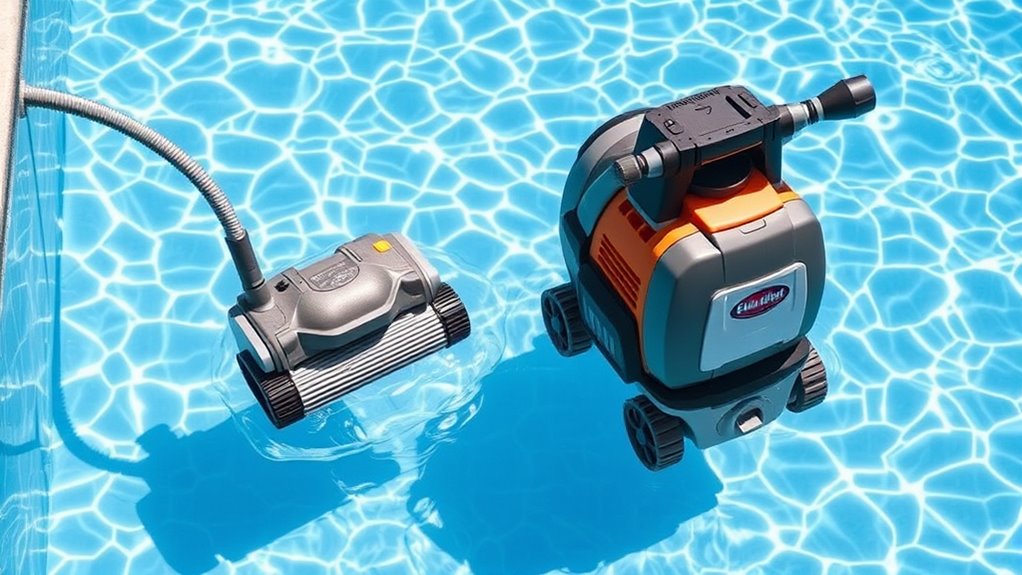
While both suction and pressure pool cleaners keep your pool tidy, they work quite differently. Suction cleaners attach directly to your skimmer or dedicated suction line, relying on your pool’s water circulation to operate. They use the pool’s pump to vacuum debris, making them effective for small to medium debris and maintaining pool chemicals evenly. In addition, suction pool cleaners are generally more affordable and easier to install, making them a popular choice for many pool owners. In contrast, pressure cleaners connect to a dedicated pressure line and use pressurized water to propel themselves around the pool. They’re typically better for larger debris and stubborn dirt, offering more thorough cleaning in bigger pools. Understanding these differences helps you choose the right cleaner for your pool’s size and debris load, ensuring ideal water circulation and maintaining proper pool chemicals for a sparkling, clean pool. Additionally, selecting the appropriate cleaner can help reduce overall maintenance costs and extend the lifespan of your pool equipment by optimizing water flow and filtration. Furthermore, modern pressure cleaners often incorporate advanced navigation technology to improve cleaning efficiency. Properly matching your cleaner type to your pool’s specific needs can also enhance overall pool maintenance and prolong equipment lifespan. Being aware of the different operating mechanisms can help you make more informed decisions and achieve better pool cleanliness results.
Assessing Your Pool’s Size and Shape for Compatibility
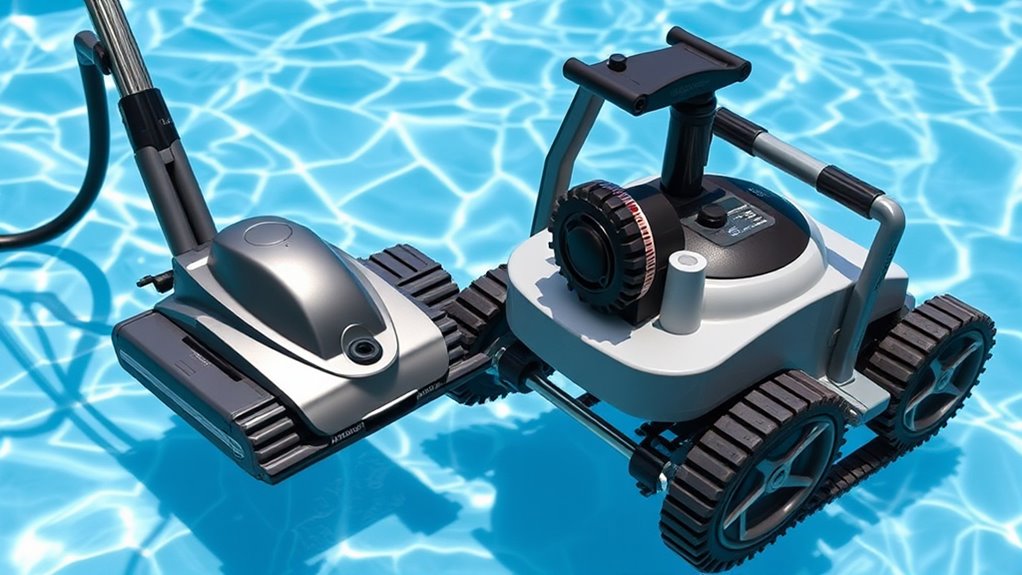
To determine if a pressure cleaner suits your pool, you need to contemplate its size and shape. Measure the dimensions and layout to see if the cleaner can navigate comfortably. Make sure the cleaner type matches your pool’s design for effective and efficient cleaning. Additionally, consider industry trends to ensure the cleaner you choose aligns with current technology and best practices. Understanding pool maintenance techniques can also help you select a model that minimizes effort and maximizes cleanliness. Evaluating your pool’s tuning options can further assist in choosing a compatible cleaning system that complements your existing setup. Incorporating performance metrics can help you assess how well the cleaner performs in different pool shapes and sizes. Furthermore, reviewing installation requirements can ensure compatibility with your pool’s plumbing and equipment setup.
Pool Dimensions and Layout
Before switching from a suction to a pressure pool cleaner, you need to evaluate your pool’s dimensions and layout to guarantee compatibility. Measure the length, width, and depth to ensure the cleaner can navigate effectively. If your pool has complex corners or a narrow entry, a pressure cleaner might struggle without proper adjustments. Consider your pool lighting, as well-placed lighting can help monitor the cleaner’s progress. Water chemistry also plays a role; balanced chemicals prevent debris buildup that could clog the cleaner. Large or irregularly shaped pools typically benefit from pressure cleaners with greater power, while smaller pools may do fine with suction models. Understanding your pool’s size and layout helps you choose a pressure cleaner that maximizes coverage and efficiency. Additionally, pool surface type can influence the effectiveness of different cleaning methods, so it’s important to match your cleaner to your pool’s material. Proper pool maintenance routines can also prolong the life and performance of your new pressure cleaner. Regular inspections and cleaning schedules ensure consistent operation and help prevent potential issues. Employing the right pressure settings can optimize cleaning performance based on your pool’s specific features. Being aware of the clogging risks associated with debris and water chemistry can further improve your cleaning results.
Compatibility With Cleaner Type
Evaluating your pool’s size and shape is crucial to guarantee compatibility with a pressure cleaner. Larger pools with complex layouts benefit from pressure cleaners, which cover more ground efficiently. Smaller or irregularly shaped pools might be better suited for robotic cleaners or manual skimmers. Consider the following factors: pool shape and size can significantly influence the cleaning method’s effectiveness. Additionally, understanding the cleaner type compatibility with your pool’s features ensures optimal cleaning performance. Matching your pool’s features with cleaner capabilities ensures effective cleaning without compatibility issues, especially when considering cleaning system requirements. Recognizing the pool surface material can also impact the effectiveness of different cleaning systems, helping you choose the most suitable option.
Gathering the Necessary Equipment and Tools for the Switch
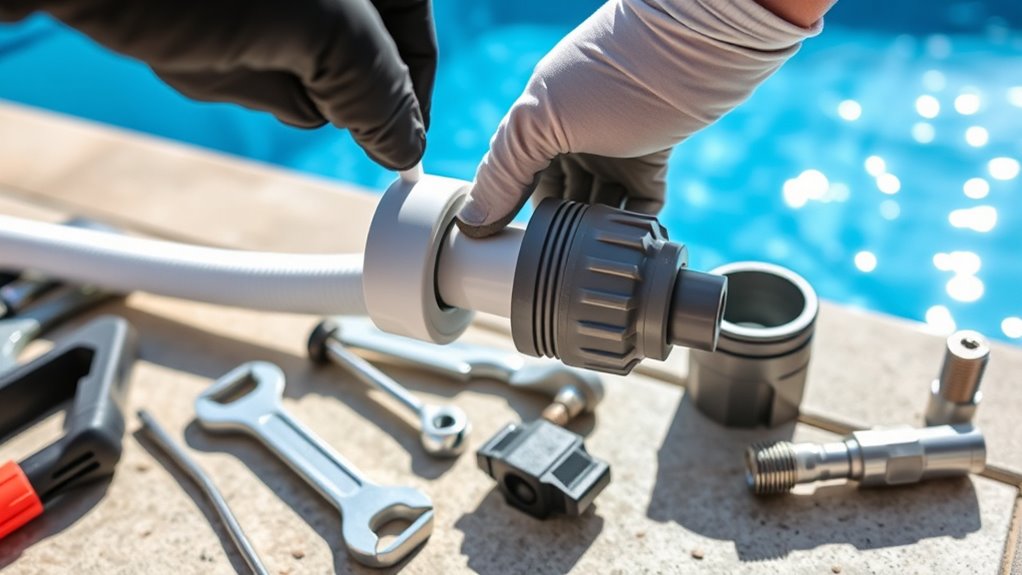
Before you start switching, gather all the necessary equipment and tools to make the process smooth. Check off items from your essential equipment list and confirm you have the right tools for installation. Also, verify that your new pressure cleaner is compatible with your pool’s setup to prevent any surprises later. Ensuring proper equipment maintenance can help avoid issues like clogs or malfunctions during the switch. Additionally, reviewing Ford Tuning options can inspire modifications to optimize your pool cleaner’s performance and longevity. Regular inspections and adjustments based on well-being tips can further prolong the lifespan of your equipment and ensure optimal operation. Keeping your system clean and well-maintained is crucial for consistent performance efficiency and avoiding unnecessary repairs. Being aware of regional resources can also assist if you need professional support or replacement parts in your area.
Essential Equipment Checklist
Switching from a suction to a pressure pool cleaner requires gathering specific equipment to guarantee a smooth transition. First, confirm you have the right parts, including hoses, fittings, and adapters compatible with your pool’s setup. You’ll also need pool chemicals to balance water chemistry, preventing algae and debris buildup. Don’t forget pool covers to protect equipment when not in use.
Here’s a quick checklist:
| Equipment | Purpose |
|---|---|
| Hoses and fittings | Connect pressure cleaner to pump |
| Pool chemicals | Maintain water quality during operation |
| Adapters and connectors | Ensure secure and leak-free connections |
| Pool covers | Protect equipment and keep debris out when idle |
Gathering these essentials prepares you for a seamless switch.
Proper Tool Identification
To successfully shift from a suction to a pressure pool cleaner, you need to identify and gather the right tools and equipment. First, confirm you have your pressure pump and hose compatible with your pool’s size and type, which is essential for effective pool cleaning. Check that your cleaner’s accessories, such as hoses, fittings, and connectors, are in good condition and fit properly. Having a wrench or pliers handy will help during equipment maintenance or adjustments. Additionally, gather any adapters needed to connect your pressure cleaner to the existing pool plumbing. Proper tool identification guarantees a smooth transition, minimizes downtime, and maintains your equipment’s longevity. Being prepared with the right equipment makes your pool cleaning process more efficient and less stressful.
Compatibility Verification
Begin by confirming that your pool’s equipment matches the requirements for a pressure cleaner. Check if your pump and filter system can handle the increased flow and pressure, guaranteeing compatibility. Inspect your pool cover to make sure it won’t interfere with the cleaner’s movement or hose connections. Proper chemical balancing is essential; unbalanced water can cause the cleaner to malfunction or wear out prematurely. Verify that your pool’s fittings and skimmer are compatible with the pressure cleaner’s hose and connection points. Gather necessary tools like adapters or connectors if needed. Ensuring your equipment is compatible prevents damage and ensures efficient operation. Once confirmed, you’re ready to proceed with the switch confidently, knowing your setup supports the new pressure cleaner properly.
Preparing Your Pool for the Transition
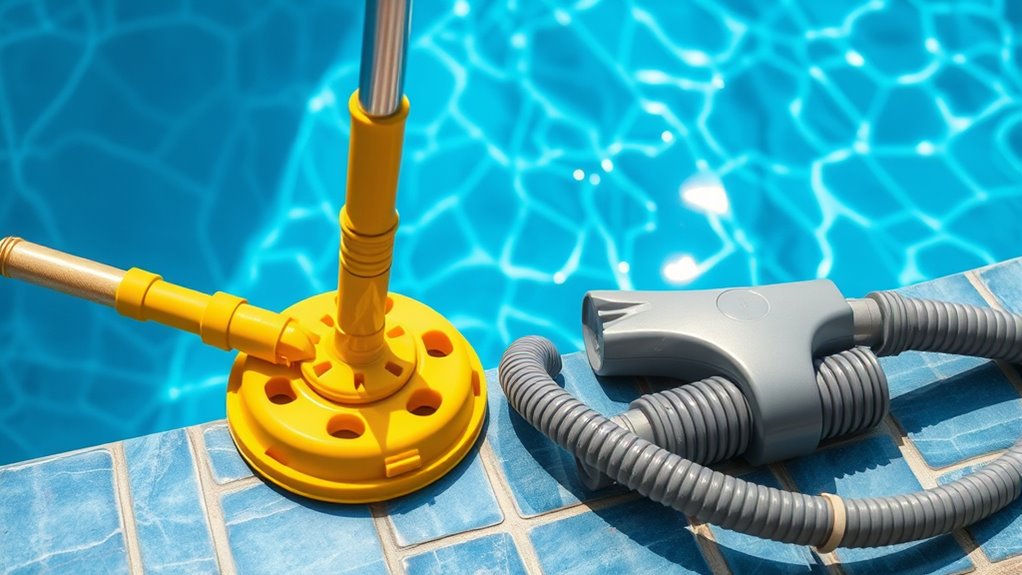
Before switching from your suction to a pressure pool cleaner, it’s essential to prepare your pool properly. Start by checking the pool chemical balance, ensuring pH, alkalinity, and sanitizer levels are within ideal ranges. Proper chemical balance helps prevent algae growth and keeps your water clear during the transition. Additionally, consider seasonal pool coverage; if your pool is going to be unused for a while, adjust the cover and skimming tools accordingly to avoid debris buildup. Clear the water of leaves, dirt, and other debris to prevent clogging your new pressure cleaner. Finally, inspect and clean your pool’s filter system. A clean filter guarantees optimal circulation and helps your pressure cleaner operate efficiently from the start.
Removing and Storing Your Suction Pool Cleaner
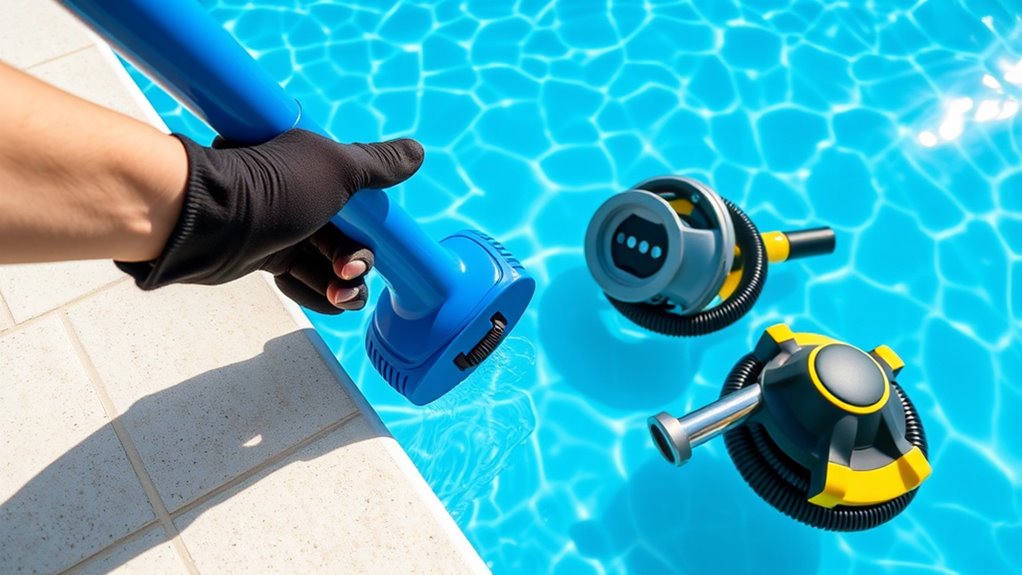
Once you’ve prepared your pool for switching cleaners, it’s time to remove and store your suction pool cleaner properly. First, turn off your pool pump and disconnect the cleaner’s hose. Rinse the cleaner thoroughly with fresh water to remove chlorine, dirt, and debris. Check your pool’s chemical balancing to guarantee water quality is ideal before storage. Next, wind the hose neatly to prevent kinks or damage. Store the cleaner in a dry, shaded area, away from direct sunlight, to prolong its lifespan. If you’re closing the pool for the season, consider covering it with a seasonal pool cover to protect it from dirt and debris. Proper storage helps maintain your suction cleaner’s performance and extends its usability for future seasons.
Installing the Pressure Pool Cleaner System
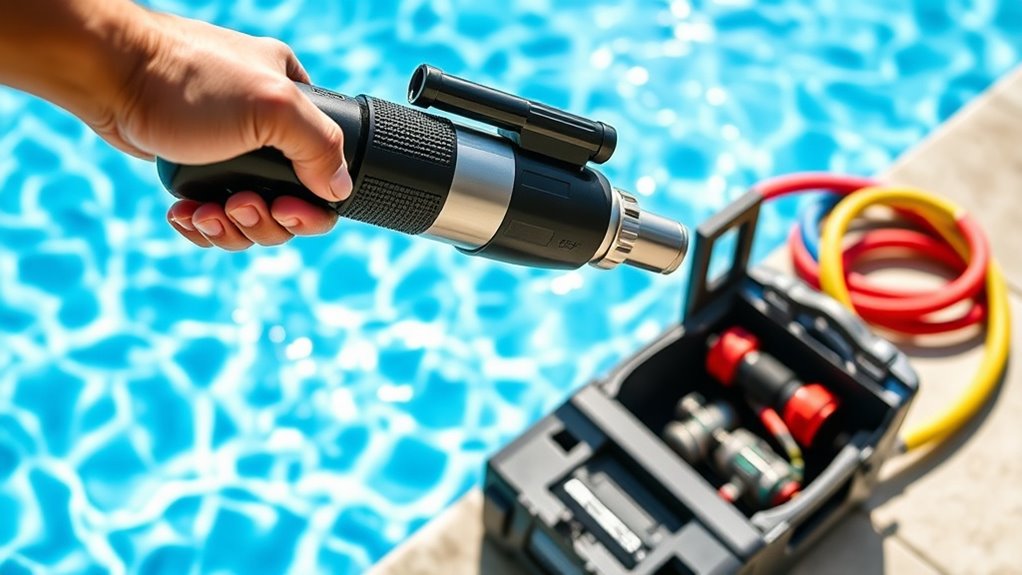
To install your pressure pool cleaner system, start by locating your pool’s existing return jet and ensuring it’s suitable for attachment. Check that the jet’s size matches the pressure cleaner’s fitting. Before connecting, verify that your water chemistry and pool chemicals are balanced; proper water chemistry prevents buildup and guarantees ideal cleaning performance. Turn off the pump and clean the return jet area to ensure a secure fit. Attach the pressure cleaner hose securely to the return jet, making sure it’s tight and leak-free. Once installed, turn the pump back on and observe the cleaner’s movement. Regularly monitor water chemistry and pool chemicals to maintain the system’s efficiency and prevent debris buildup, ensuring your pressure pool cleaner works smoothly and keeps your pool spotless.
Connecting the Pressure Cleaner to Your Pool’s Filtration System
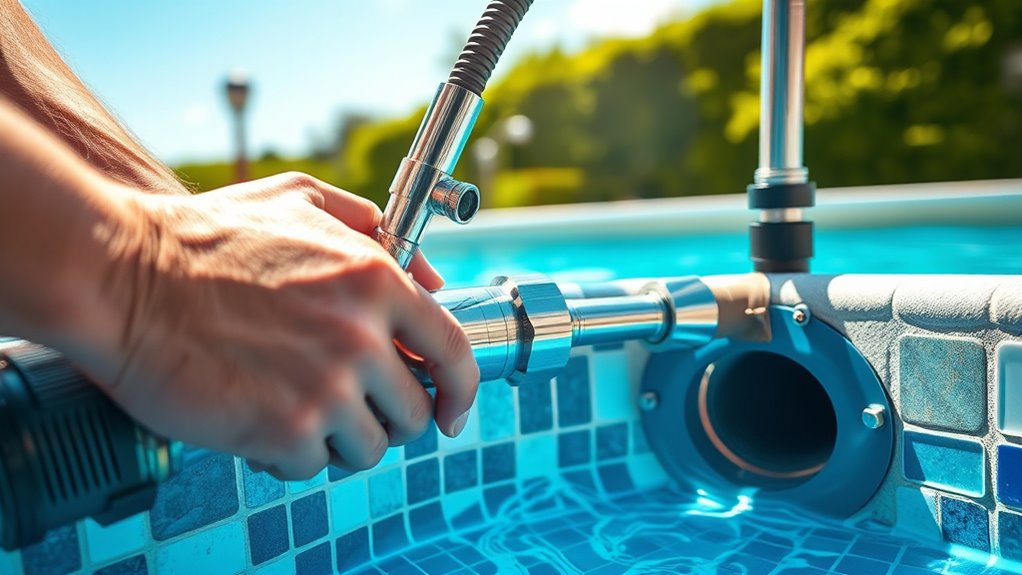
To connect your pressure cleaner, start by attaching the proper hose securely to your pool’s return line. Next, adjust the pressure settings to guarantee ideal cleaning without overloading your system. Finally, verify that your filtration system is compatible to avoid any operational issues.
Proper Hose Attachment
Connecting your pressure pool cleaner to the filtration system requires careful attachment of the hose to guarantee proper operation. First, verify your automatic vacuum hose is securely connected to the cleaner’s inlet and the outlet fitting. Attach the hose to the pool’s return jet or dedicated pressure port, not directly to the pool skimmer, to avoid disrupting your automatic vacuum or skimmer function. Make sure the hose is long enough to reach across the pool’s bottom without kinks or tangles. Check that the connections are snug and airtight, preventing leaks that could reduce pressure. Proper attachment ensures the cleaner receives adequate water flow and pressure, allowing it to move efficiently and clean thoroughly. A secure setup minimizes operational issues and maximizes cleaning performance.
Adjusting Pressure Settings
Adjusting the pressure settings on your pool’s filtration system is essential for the ideal performance of your pressure cleaner. Proper pressure guarantees thorough cleaning without damaging your pool or equipment. To optimize your setup:
- Set the pressure gauge to match your pool’s size and water chemistry.
- Test the cleaner on the pool deck first, ensuring steady, consistent movement.
- Make small adjustments to avoid over-pressurizing, which can cause water squirts or incomplete cleaning.
- Monitor the water chemistry regularly, since imbalanced water can affect pressure and cleaner efficiency.
Getting these settings right will give you a sparkling pool and peace of mind. Remember, balance in water chemistry and correct pressure are key to a flawless clean.
Ensuring System Compatibility
Before attaching your pressure pool cleaner, you need to verify that your system can support it properly. Check your pool’s filtration system for compatibility, ensuring it has enough flow rate and pressure. Proper pool chemical balancing is essential, as unbalanced chemicals can damage the cleaner or reduce effectiveness. If you use a solar cover, make sure it’s removed during cleaning to prevent interference with the pressure flow. Inspect your filter and pump to verify they can handle the cleaner’s requirements without causing strain. Additionally, ensure your plumbing connections are secure, and consider upgrading components if necessary. Confirming these factors helps avoid system strain or damage, ensuring your pressure cleaner operates smoothly and efficiently.
Configuring and Testing the Pressure Pool Cleaner

Once you’ve installed the pressure pool cleaner, it’s essential to properly configure and test it to guarantee peak performance. Start by ensuring your pool’s chemical balance is ideal so the cleaner operates smoothly without damage. Next, check that the pressure valve is set correctly, adjusting for effective cleaning without stressing the pool surface. Test the cleaner by turning on the pump and observing its movement, making sure it covers all areas evenly. Finally, monitor the cleaner closely during its first run, ensuring it doesn’t disturb pool surface protection. Use these steps to evoke confidence:
- Confirm the pressure levels are appropriate for thorough cleaning
- Adjust settings for maximum coverage without harming the pool surface
- Watch for consistent, smooth movement across all pool areas
- Verify that the cleaner doesn’t interfere with chemical balance or surface integrity
Troubleshooting Common Issues During the Transition
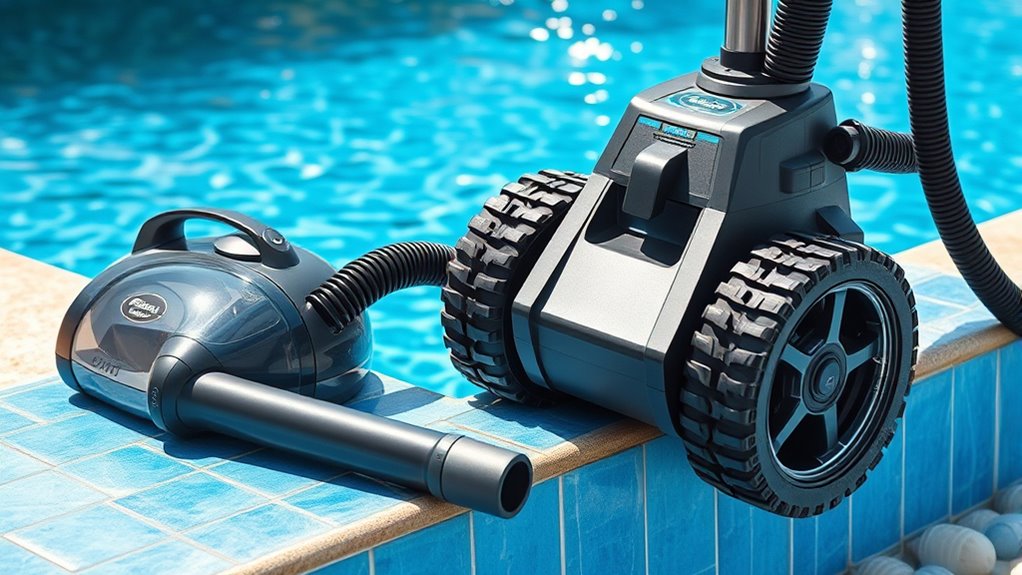
After configuring and testing your pressure pool cleaner, you might encounter some common issues that can hinder its performance. One problem is reduced cleaning efficiency, often caused by clogged filters or blocked hoses. Regularly check and clear these to ensure maximum flow. Another issue is excessive energy consumption, which may result from incorrect pressure settings or leaks in hoses and fittings. Verify that your pressure is set according to the manufacturer’s recommendations and inspect all connections for leaks. Additionally, uneven coverage or missed spots can indicate misaligned or tangled hoses. Address these problems promptly to maintain consistent cleaning. Troubleshooting these common issues helps improve cleaning efficiency and prevents unnecessary energy waste, ensuring your pool stays clean while keeping operation costs in check.
Maintaining Your New Pressure Pool Cleaner for Optimal Performance
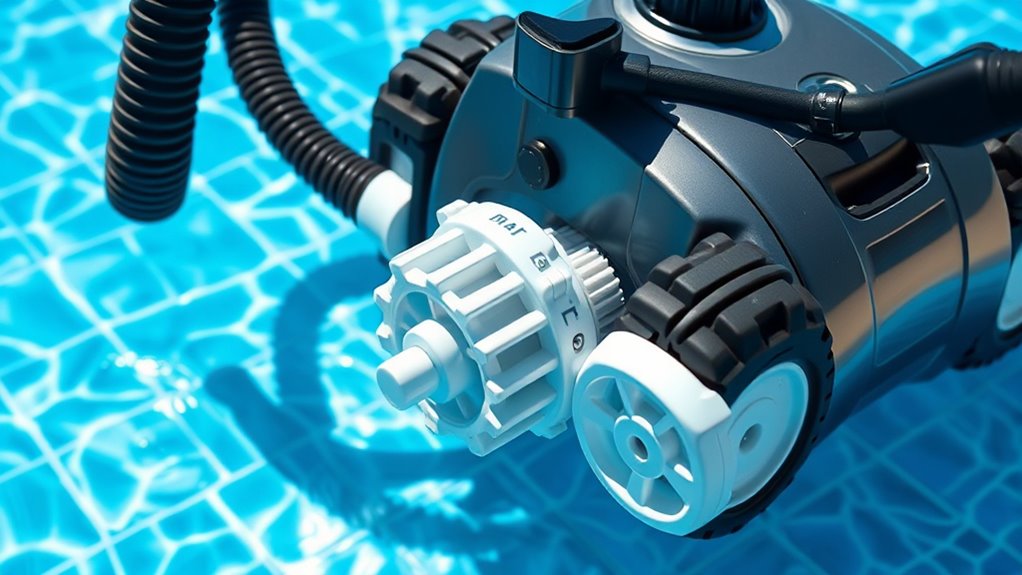
To keep your new pressure pool cleaner performing at its best, regular maintenance is essential. Properly balancing your pool chemistry ensures the cleaner works efficiently and prolongs its lifespan. Follow these steps to maintain peak performance:
- Check and adjust pool chemistry weekly to prevent debris buildup and protect internal parts.
- Clean the filter regularly, ensuring ideal suction and pressure.
- Inspect hoses and fittings for leaks or blockages, replacing parts as needed.
- Follow safety precautions when handling chemicals or performing maintenance to avoid accidents.
Frequently Asked Questions
Can I Switch Between Suction and Pressure Pool Cleaners Easily?
You can switch between suction and pressure pool cleaners, but it requires verifying compatibility concerns first. Make sure your pool’s skimmer and filter system support the cleaner type you want to use. Regular maintenance tips include cleaning the skimmer basket and checking hoses for leaks. Switching isn’t always straightforward, so follow manufacturer instructions carefully to ensure your system works efficiently and to prevent damage.
How Often Should I Service My New Pressure Pool Cleaner?
You should follow a regular maintenance schedule for your pressure pool cleaner, ideally inspecting and cleaning it weekly to guarantee peak performance. Check the brushes, hoses, and filters, and clear out any debris that might clog the system. The cleaning frequency depends on your pool’s usage and surroundings, but staying consistent with maintenance helps prevent issues and keeps your cleaner running smoothly for longer, saving you time and effort.
Are There Specific Pool Types Better Suited for Pressure Cleaners?
You should consider your pool surface and debris management needs when choosing a pressure cleaner. These cleaners work best on smooth, concrete, or vinyl surfaces, where they can easily navigate and clean effectively. They excel at handling larger debris, making them ideal if your pool often collects leaves or bigger particles. If debris management and a sturdy pool surface matter, a pressure cleaner offers efficient, targeted cleaning without much hassle.
Will Switching Cleaners Affect My Pool’S Water Chemistry?
Your pool’s water chemistry is already a delicate dance, and a switch in cleaner can feel like a tornado hitting your water balance! Don’t worry—using a pressure cleaner might slightly alter your pool water balance, but it’s easy to handle with a few quick chemical adjustments. Keep testing regularly, and you’ll maintain perfect clarity, ensuring your pool stays inviting and safe, no matter the cleaner.
What Safety Precautions Should I Take During the Switch?
When switching pool cleaners, you should prioritize electrical safety by unplugging power sources before handling equipment. Wear gloves and protective gear to guarantee safe chemical handling if you’re adjusting chemicals or cleaning parts. Always follow manufacturer instructions, keep electrical cords away from water, and avoid working alone in case of emergencies. These precautions help prevent accidents, assuring a safe and smooth shift between your pool cleaning systems.
Conclusion
Switching from a suction to a pressure pool cleaner might seem intimidating, but with a little preparation, you’ll enjoy a cleaner pool with less effort. By understanding the differences and following the right steps, you can make the transition smoothly. Are you ready to upgrade your pool cleaning routine and enjoy sparkling water all season long? Embrace the change and keep your pool pristine with your new pressure cleaner—you won’t regret it.
